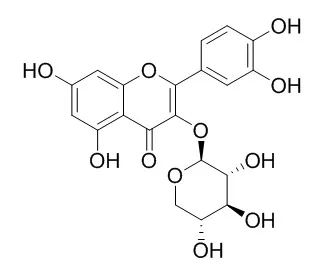| In vitro: |
| Nat Prod Res. 2012;26(3):274-7. | | Antioxidant potential and radical-scavenging effects of flavonoids from the leaves of Psidium cattleianum grown in French Polynesia.[Pubmed: 22077157 ] | Psidium cattleianum J. Sabine (Myrtaceae) is a traditional medicinal plant in French Polynesia. The leaves and roots possess many medicinal properties. These effects may be correlated with the presence of antioxidant compounds.
METHODS AND RESULTS:
Seven flavonoids along with a benzoic acid were isolated from the leaves of P. cattleianum. The compounds indicated strong antioxidant and radical-scavenging activities in ALP, DPPH(·), ABTS(·-) and ORAC assays. This study demonstrates that the leaves of P. cattleianum possess main compounds with interesting antioxidant and radical-scavenging activities, as clarified by four biological assays.
CONCLUSIONS:
Our findings may justify the use of these leaves in the traditional medicine of French Polynesia. Among the total eight known compounds, Reynoutrin and luteolin were isolated for the first time from the genus Psidium. | | Food Chem. 2008 Mar 15;107(2):813-819. | | Cytotoxic chalcones and antioxidants from the fruits of a Syzygium samarangense (Wax Jambu).[Pubmed: 22359426 ] |
METHODS AND RESULTS:
Bioassay-guided fractionation of the methanolic extracts of the pulp and seeds of the fruits of Syzygium samarangense Merr. & Perry (Blume) led to the identification of four cytotoxic compounds and eight antioxidants on the basis of HPLC-PDA analysis, MS, and various NMR spectroscopic techniques.
CONCLUSIONS:
Three C-methylated chalcones, 2',4'-dihydroxy-3',5'-dimethyl-6'-methoxychalcone (1), 2',4'-dihydroxy-3'-methyl-6'-methoxychalcone (stercurensin, 2), and 2',4'-dihydroxy-6'-methoxychalcone (cardamonin, 3), were isolated and displayed cytotoxic activity (IC(50) = 10, 35, and 35 μM, respectively) against the SW-480 human colon cancer cell line. Also a number of known antioxidants were obtained including six quercetin glycosides: Reynoutrin (4), hyperin (5), myricitrin (6), quercitrin (7), quercetin (9), and guaijaverin (10), one flavanone: (S)-pinocembrin (8), and two phenolic acids: gallic acid (11) and ellagic acid (12). |
|






 Cell. 2018 Jan 11;172(1-2):249-261.e12. doi: 10.1016/j.cell.2017.12.019.IF=36.216(2019)
Cell. 2018 Jan 11;172(1-2):249-261.e12. doi: 10.1016/j.cell.2017.12.019.IF=36.216(2019) Cell Metab. 2020 Mar 3;31(3):534-548.e5. doi: 10.1016/j.cmet.2020.01.002.IF=22.415(2019)
Cell Metab. 2020 Mar 3;31(3):534-548.e5. doi: 10.1016/j.cmet.2020.01.002.IF=22.415(2019) Mol Cell. 2017 Nov 16;68(4):673-685.e6. doi: 10.1016/j.molcel.2017.10.022.IF=14.548(2019)
Mol Cell. 2017 Nov 16;68(4):673-685.e6. doi: 10.1016/j.molcel.2017.10.022.IF=14.548(2019)